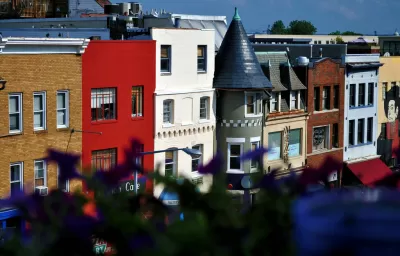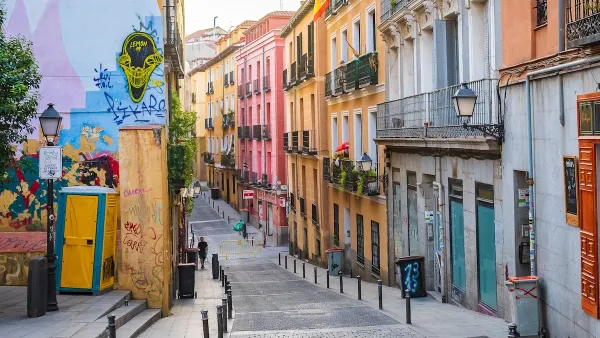Tourists are often drawn to downtown museums, sightseeing tours, and high-end restaurants. But if these travelers want to truly understand a city’s full story, they may need to take a bit of a detour.

For the frequent traveler, there's a certain spark that comes with visiting a city for the first time. It's a feeling of simultaneous excitement and uncertainty, an opportunity to turn expectation into experience.
When we travel to a new city, we take on the identity of "tourist." As such, we often participate in sightseeing activities that help us learn about where we are. We find ourselves in the downtown area of a city, often surrounded by other tourists. We hop on and off busses that transport us to museums, restaurants, and photogenic city landmarks that make our Instagram followers jealous. While tourist attractions can tell us a lot about a city's history and geography, they don't always give much insight into how the residents of a city really live.
To borrow the famous words of Atticus Finch, "You never really understand a person until you consider things from his point of view . . . until you climb into his skin and walk around in it." But what would happen if we apply this concept to cities? It's as simple as this: you never really know a city until you walk around its neighborhoods. Each neighborhood, regardless of size, is a chapter in a city's larger story. And once we understand the significance of each neighborhood, we can begin to truly comprehend the stories of the cities we choose to visit.
So what exactly can we learn from a city neighborhood? That, of course, depends on where we are. On September 24,, 2016, during the historic dedication ceremony of the National Museum of African American History and Culture, Washington, D.C. Mayor Muriel Bowser remarked on the rich history of African Americans in the United States and communicated her thoughts on the current political climate to a crowd of mostly visitors to the nation's capital, some of whom had never been before. When many of us think about a trip to Washington, D.C., we perhaps envision a visit to the three Ms: Monuments, museums, and memorials. The travel guides and TripAdvisor-esque websites tell us that a visit to D.C. is not complete without including a trip to the White House and the Capitol Building in our itinerary.
But the travel guides often don't tell us that the neighborhoods of D.C. and the people that inhabit them are just as spectacular as the sights themselves, and nobody knows this better than the mayor of Washington, D.C., a woman born and raised in the city she calls home. Mayor Bowser concluded her speech at the dedication ceremony by giving a shout-out to D.C.'s historic neighborhoods: "Please enjoy your visit to my hometown, embrace the richness of our neighborhoods from historic Anacostia where Frederick Douglass made his home to U Street where Duke Ellington had his roots," she said. Sometimes, the best way to understand a city is to visit the specific neighborhoods where its history has been made.
Other times, neighborhoods exemplify the social and political climates of their cities. For example, the city of San Francisco's population is rapidly increasing due to an influx of young tech professionals, and there's no better place to examine the city's new urban landscape than the Mission District. In this neighborhood—which in the '80s and '90s saw an influx of immigrants and refugees from South and Central America and became hipsterized during the dotcom boom—there is a distinct divide between neighborhood blocks. The eastern and southern sides of the neighborhood are home to a large Latino population, while the western and northern sides of the neighborhood are inhabited by a mostly white and affluent population. Despite the Mission District's rapid gentrification and spike in housing prices, there remains a plethora of delicious and inexpensive South and Central American cuisine.
But you wouldn't know anything about the Mission District, or that it even exists at all, unless you did your research. San Francisco's most popular city bus tours bring visitors across the Golden Gate Bridge and the touristy Fisherman's Wharf area, but very few take people through the neighborhoods that can teach the most about San Francisco's communities.
In fact, this trend in the tourism industry is evident in cities outside the United States as well. The city of Berlin, for example, boasts "pay what you wish" walking tours for travelers on a budget. General tours of Berlin, which tend to be the most popular, typically take visitors to historic and cultural sites such as the Brandenburg Gate, Checkpoint Charlie, and the Memorial to the Murdered Jews of Europe. These sites serve a fundamental purpose: to preserve artifacts from and educate tourists about Germany's loaded history.
But Berlin's top sightseeing companies also offer an alternative tour, which gives tourists a glance into Berlin's many personalities. These tours cover neighborhoods like Kreuzberg, which shows off the city's overwhelmingly eclectic character. Located a hop, skip, and a jump from the city's famous East Side Gallery, Kreuzberg merges art, politics, and social activism with its elaborate and explicit murals. The tight-knit neighborhood of Kreuzberg is home to an excess of small businesses, and will likely stay that way. The city once tried to build a chain retail store, and residents held protests to prevent the operation. Kreuzberg is a neighborhood like no other. Yet for some reason, it makes very few of the "top places to see" lists.
And maybe that's not an accident. After all, the tourism industry caters to the interests of, well, the tourists. And traditionally, many tourists have found more pleasure in sightseeing than discovering and exploring new neighborhoods.
But what if tourists were to change their attitude when they visit a new city? What if, in addition to searching for the best views and museums in a city, visitors expressed an interest in something different, in a taste of the real, unfiltered urban experience? Perhaps the industry that caters to them would follow.
Bio: Tara Lerman is a writer and editor in Washington, DC. Her work has been published in The Hill, Greater Greater Washington, and The Saratogian News. Tara's writing can be found at https://taralerman.wordpress.com.

Planetizen Federal Action Tracker
A weekly monitor of how Trump’s orders and actions are impacting planners and planning in America.

San Francisco's School District Spent $105M To Build Affordable Housing for Teachers — And That's Just the Beginning
SFUSD joins a growing list of school districts using their land holdings to address housing affordability challenges faced by their own employees.

The Tiny, Adorable $7,000 Car Turning Japan Onto EVs
The single seat Mibot charges from a regular plug as quickly as an iPad, and is about half the price of an average EV.

Seattle's Plan for Adopting Driverless Cars
Equity, safety, accessibility and affordability are front of mind as the city prepares for robotaxis and other autonomous vehicles.

As Trump Phases Out FEMA, Is It Time to Flee the Floodplains?
With less federal funding available for disaster relief efforts, the need to relocate at-risk communities is more urgent than ever.

With Protected Lanes, 460% More People Commute by Bike
For those needing more ammo, more data proving what we already knew is here.
Urban Design for Planners 1: Software Tools
This six-course series explores essential urban design concepts using open source software and equips planners with the tools they need to participate fully in the urban design process.
Planning for Universal Design
Learn the tools for implementing Universal Design in planning regulations.
Smith Gee Studio
City of Charlotte
City of Camden Redevelopment Agency
City of Astoria
Transportation Research & Education Center (TREC) at Portland State University
US High Speed Rail Association
City of Camden Redevelopment Agency
Municipality of Princeton (NJ)



























